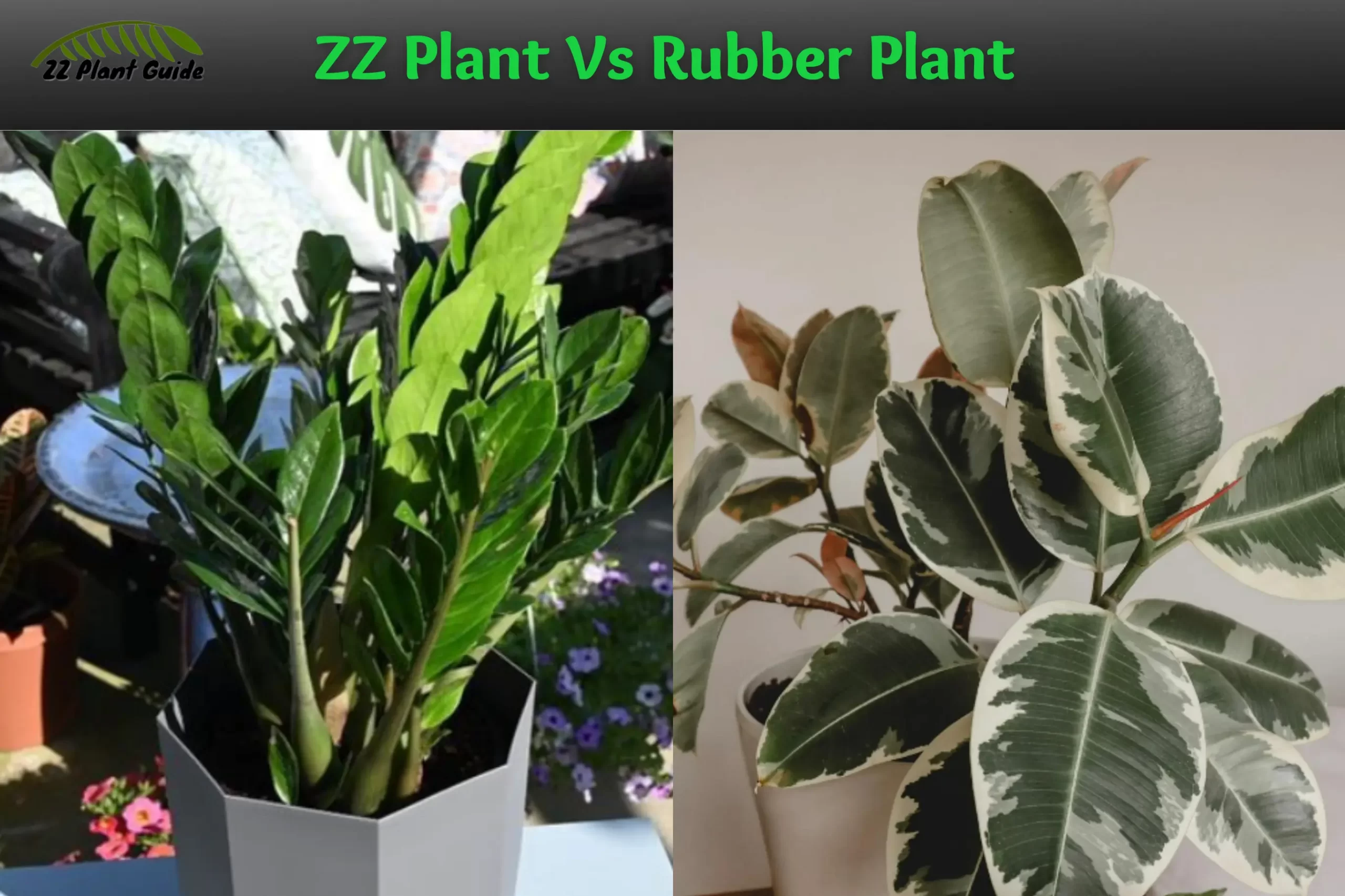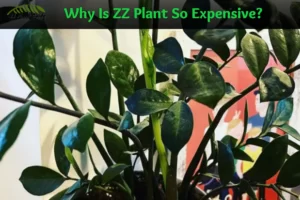In one corner, we have the ZZ Plant, the Indestructible Master. And in the other, the Rubber Plant, the Elegant Giant. Who will emerge victorious?
Which plant will you choose to brighten up your home? Only you can decide, but we’re here to help with all the juicy details.
ZZ Plant Vs Rubber Plant
ZZ Plant: The Indestructible Master
Latin Name: Zamioculcas zamiifolia
Nickname: The Indestructible Master (we just made that up, but it sounds cool!)
The ZZ Plant is like the Bruce Willis of houseplants – it’s nearly impossible to kill. With its shiny, waxy leaves and its ability to thrive in low light and drought conditions, this plant is perfect for both the dedicated plant parent and the absent-minded plant sitter.
Some say it’s impossible to have a brown thumb with a ZZ Plant in the house, and we’re inclined to agree!
Fun Facts about the ZZ Plant:
- Native to Eastern Africa, the ZZ Plant has been thriving in harsh conditions since, like, forever.
- It’s sometimes called the “Eternity Plant” because it can survive without water for a looong time. Talk about low maintenance!
- ZZ Plants are known for their air-purifying abilities, making them great for indoor spaces. (Breathe deeply, my friends!)
Rubber Plant: The Elegant Giant
Latin Name: Ficus elastica
Nickname: The Elegant Giant (again, we made that up, but it’s catchy!)
The Rubber Plant is a tall, dark, and handsome houseplant with large, glossy leaves that can grow up to 12 inches long. It’s like the George Clooney of plants – refined, dignified, and a little mysterious.
This plant requires a bit more attention than the ZZ Plant, but it’s worth it for the aesthetic payoff. In the right conditions, a Rubber Plant can grow to be over 8 feet tall! Talk about a statement piece.
Fun Facts about the Rubber Plant:
- Native to Southeast Asia, the Rubber Plant is part of the fig family. However, unlike its cousin the edible fig, this plant is not for snacking.
- The Rubber Plant gets its name from the sticky, white sap in its leaves, which was once used to make rubber (but let’s leave that to the professionals).
- These plants are also known for their air-purifying abilities, making your home a cleaner, fresher place to be.
ZZ Plant vs. Rubber Plant – A Snapshot
| Category | ZZ Plant | Rubber Plant |
| Size | Up to 3 feet | Up to 8 feet or more |
| Light | Low to medium | Bright, indirect light |
| Water | Drought-tolerant | Moderate, allow to dry |
| Soil | Well-draining | Well-draining |
| Fertilizer | Every 4-6 months | Monthly during growth |
| Humidity | Low to average | Moderate to high |
| Toxicity | Toxic to pets | Toxic to pets |
| Difficulty | Easy peasy lemon squeezy | Intermediate level |
Caring for Your Plant: ZZ vs. Rubber Edition
Both the ZZ Plant and the Rubber Plant have their unique quirks when it comes to care, but we’ll break it down in simple terms, just for you!
ZZ Plant Care:
- Light: These bad boys are low-light champs, but they’ll be even happier with a little medium, indirect sunlight.
- Water: Water your ZZ Plant sparingly, and only when the soil is dry. Overwatering is its only true nemesis.
- Soil: Well-draining soil is the way to go. The ZZ Plant hates soggy roots!
Rubber Plant Care:
- Light: The Rubber Plant loves bright, indirect light. Avoid direct sun rays to prevent leaf scorching.
- Water: Keep the soil moist but not soggy. Allow the top inch to dry out between waterings.
- Soil: Use well-draining soil to keep your Rubber Plant’s roots happy and healthy.
Examples: Celebrities Who Love ZZ and Rubber Plants
You’re not the only one debating between a ZZ Plant and a Rubber Plant! Check out these famous faces who are also proud plant parents.
- Emma Watson: Our favorite bookworm-turned-actress has been spotted with a lovely Rubber Plant in her home.
- Dwayne “The Rock” Johnson: Believe it or not, the tough guy has a soft spot for ZZ Plants. He’s posted pictures of his on social media.
- Taylor Swift: Tay-Tay’s home has been featured in several magazines, and a Rubber Plant has been seen gracing her living room.
And the Winner Is…
We hate to leave you hanging, but the winner of the ZZ Plant vs. Rubber Plant showdown really depends on you! Are you looking for a low-maintenance, nearly indestructible plant that can survive your occasional forgetfulness?
Then the ZZ Plant is your new best friend. If you’re looking for a stunning, statement-making plant that you can dote on and watch grow, then the Rubber Plant is calling your name.
FAQs
While it may be tempting to create a mini jungle in one pot, it’s not recommended. ZZ Plants and Rubber Plants have different water and soil requirements, which could lead to one plant thriving while the other struggles.
Both plants are considered toxic to pets and can cause irritation if ingested by children. Keep these plants out of reach of curious little hands and paws to avoid any accidents.
While both plants can produce flowers, it’s rare for them to do so indoors. ZZ Plants occasionally produce small, inconspicuous flowers near the base, while Rubber Plants can produce small, greenish-white flowers in their natural habitat.
Both plants can be susceptible to common pests like mealybugs, spider mites, and scale insects. To treat infestations, use insecticidal soap or neem oil on the affected areas, and regularly wipe down the leaves to prevent future issues.
Both plants can be grown outdoors, but only in suitable climates. ZZ Plants can handle warmer temperatures and drought conditions, while Rubber Plants prefer consistently warm and humid environments. Both plants should be protected from direct sunlight and freezing temperatures.




